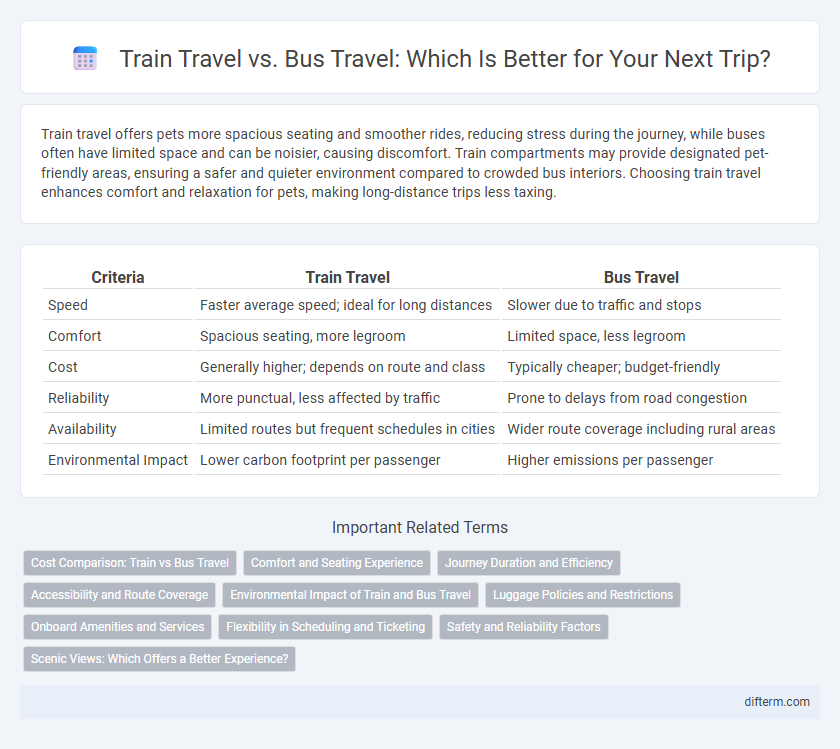Train travel offers pets more spacious seating and smoother rides, reducing stress during the journey, while buses often have limited space and can be noisier, causing discomfort. Train compartments may provide designated pet-friendly areas, ensuring a safer and quieter environment compared to crowded bus interiors. Choosing train travel enhances comfort and relaxation for pets, making long-distance trips less taxing.
Table of Comparison
| Criteria | Train Travel | Bus Travel |
|---|---|---|
| Speed | Faster average speed; ideal for long distances | Slower due to traffic and stops |
| Comfort | Spacious seating, more legroom | Limited space, less legroom |
| Cost | Generally higher; depends on route and class | Typically cheaper; budget-friendly |
| Reliability | More punctual, less affected by traffic | Prone to delays from road congestion |
| Availability | Limited routes but frequent schedules in cities | Wider route coverage including rural areas |
| Environmental Impact | Lower carbon footprint per passenger | Higher emissions per passenger |
Cost Comparison: Train vs Bus Travel
Train travel generally incurs higher ticket prices compared to bus travel, driven by faster speeds and greater comfort amenities. Bus travel offers more economical fares, especially for short distances or budget-conscious travelers, with widespread route availability. Evaluating total costs should include factors like travel time efficiency, convenience, and potential discounts for frequent travelers on trains.
Comfort and Seating Experience
Train travel offers spacious seating with ample legroom and reclining options, enhancing comfort on long journeys. In contrast, bus travel typically provides more compact seating with limited adjustability, potentially causing discomfort during extended trips. Modern trains often feature ergonomic designs and onboard amenities like dining cars and restrooms, further improving the overall travel experience compared to standard buses.
Journey Duration and Efficiency
Train travel typically offers shorter journey durations compared to bus travel due to higher average speeds and fewer stops along the route. Efficiency in train travel is enhanced by dedicated tracks and streamlined boarding processes, reducing delays and improving punctuality. In contrast, bus travel often faces traffic congestion and variable stops, resulting in longer and less predictable travel times.
Accessibility and Route Coverage
Train travel offers extensive route coverage across major cities and regions, providing accessible stations equipped with facilities for passengers with disabilities, including ramps, elevators, and tactile guidance paths. Bus travel often reaches rural or remote areas beyond train lines, with flexible stops that increase accessibility in less-connected regions despite limited accessibility features compared to trains. Evaluating accessibility and route coverage reveals that trains excel in urban and intercity networks, while buses provide vital connections to underserved or off-track locations.
Environmental Impact of Train and Bus Travel
Train travel produces significantly lower carbon emissions per passenger kilometer compared to bus travel, largely due to higher energy efficiency and the potential use of renewable electricity. Buses typically rely on diesel fuel, resulting in greater air pollution and greenhouse gas emissions. Choosing trains over buses can substantially reduce an individual's carbon footprint and contribute to more sustainable transportation.
Luggage Policies and Restrictions
Train travel generally offers more generous luggage policies, allowing passengers to carry multiple bags with higher weight limits without extra fees. In contrast, bus travel often imposes stricter luggage restrictions, limiting the number of bags and enforcing tighter size and weight limits, sometimes charging additional fees for oversized or excess baggage. Passengers prioritizing convenience and fewer luggage constraints typically prefer trains for long-distance journeys.
Onboard Amenities and Services
Train travel offers spacious seating, Wi-Fi connectivity, dining cars, and clean restrooms, enhancing passenger comfort during long journeys. Bus travel typically provides more limited amenities, often lacking onboard restrooms and reliable internet access, which can affect comfort on extended routes. Travelers seeking convenience and enhanced services often prefer trains for their superior onboard experience.
Flexibility in Scheduling and Ticketing
Train travel offers greater flexibility in scheduling with frequent departures throughout the day and multiple ticket options, including refundable and changeable fares. Bus travel typically has fewer daily trips and more rigid ticketing policies, limiting last-minute changes or cancellations. Passengers seeking adaptable travel plans benefit from the diverse scheduling and flexible ticketing systems available in rail services.
Safety and Reliability Factors
Train travel offers superior safety records compared to bus travel, with fewer accidents per passenger mile due to advanced signaling systems and dedicated tracks. Reliability is enhanced by fixed schedules and less susceptibility to traffic delays, making trains a consistent choice for timely arrivals. Buses, while flexible in routes, face variable road conditions and higher accident rates, impacting both safety and punctuality.
Scenic Views: Which Offers a Better Experience?
Train travel provides panoramic windows and elevated tracks that showcase expansive landscapes, making it ideal for scenic views. Bus routes often navigate highways and urban areas, limiting opportunities to experience natural beauty and picturesque vistas. Travelers seeking immersive scenery typically prefer trains for their smooth ride and vantage points through mountains, coastlines, and countryside.
Train travel vs Bus travel Infographic

 difterm.com
difterm.com